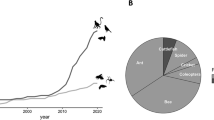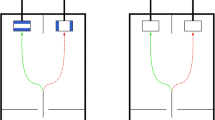Abstract
Processing information about quantities allows animals to make optimal decisions during many natural contexts, such as foraging, territorial defense, offspring care, mate choice, and intra-sexual competition. Compared to the wealth of information available in vertebrates, much less is known in invertebrates, even though the processing of quantities is equally relevant for both taxa. Here, we used two separate ecologically relevant tasks (brood pile preference and landmark-guided foraging) to investigate two dimensions of quantitative cognition in carpenter ants: spontaneous quantitative judgments and trained use of sequential landmarks. Individual ants spontaneously discriminated between two piles of dummy cocoons both when the choice involved smaller (1 vs. 2, 3, 4) and larger numerical contrasts (2 vs. 4, 6, 8). Ants used both chemical and visual/tactile cues and their performance was dependent on the numerical ratio. In the second task, ants preferentially searched near the trained landmark (out of five identical ones) despite alterations in its position, suggesting that they used ordinal information about its location when searching for food. In this experiment, ants showed a limit at four since their performance drastically decreased when they were trained to the 5th landmark. We showed that carpenter ants use both relative quantity and relative position to make efficient decisions. Our study contributes to the scant body of knowledge available on quantitative cognition in invertebrate species.
Significance statement
There is ample experimental evidence that non-human animals are able to process quantitative information, in particular mammals, some birds, and fish, and that this ability is useful in a variety of ecologically relevant situations. Yet, information about quantitative cognition in invertebrates is very scarce. We show that individual ants are able to use both relative quantity and relative position of items. Nurse ants spontaneously discriminated between two brood piles of different sizes and foragers were able to learn to identify a landmark associated with food on the basis of its position in a series of identical ones. These results suggest that ants might use quantitative information to make optimal choices in their natural environment although the precise mechanisms underlying this ability should be further investigated.



Similar content being viewed by others
Data availability
The data used in this study are available at the Open Science Framework (https://osf.io/m2k3b/?view_only=73691a2fe7114712b40ebedbb6bd1da8).
References
Agrillo C, Bisazza A (2018) Understanding the origin of number sense: a review of fish studies. Phil Trans R Soc B 373:20160511
Agrillo C, Dadda M, Serena G, Bisazza A (2008) Do fish count? Spontaneous discrimination of quantity in female mosquitofish. AnimCogn 11:495–503
Agrillo C, Piffer L, Bisazza A (2011) Number versus continuous quantity in numerosity judgments by fish. Cognition 119:281–287
Agrillo C, Piffer L, Bisazza A, Butterworth B (2012) Evidence for two numerical systems that are similar in humans and guppies. PLoS ONE 7:e31923
Baker JM, Shivik J, Jordan KE (2011) Tracking of food quantity by coyotes (Canis latrans). Behav Process 88:72–75
Barnard AM, Hughes KD, Gerhardt RR, DiVincenti L Jr, Bovee JM, Cantlon JF (2013) Inher-ently analog quantity representations in olive baboons (Papio anubis). Front Psychol 4:253
Benson-Amram S, Heinen VK, Dryer SL, Holekamp KE (2011) Numerical assessment and individual call discrimination by wild spotted hyaenas, Crocuta crocuta. AnimBehav 82:743–752
Beran MJ (2017) Quantitative cognition. In: Call J, Burghardt GM, Pepperberg IM, Snowdon CT, Zentall T (eds) APA handbook of comparative psychology. American Psychological Association, Washington DC, pp 553–577
Bisazza A, Piffer L, Serena G, Agrillo C (2010) Ontogeny of numerical abilities in fish. PLoS ONE 5:e15516
Bogale BA, Aoyama M, Sugita S (2014) Spontaneous discrimination of food quantities in the jungle crow, Corvus macrorhynchos. AnimBehav 94:73–78
Brannon EM, Terrace HS (1998) Ordering of the numerosities 1 to 9 by monkeys. Science 282:746
Cacchione T, Christine Hrubesch C, Call J (2014) Phylogenetic roots of quantity processing: apes do not rely on object indexing to process quantities. Cogn Dev 31:79–95
Call J (2000) Estimating and operating on discrete quantities in orangutans (Pongo pygmaeus). J Comp Psychol 114:136–147
Cammaerts M-C (2008) Visual discrimination of cues differing as for their number of elements, their shape or their orientation, by the ant Myrmica sabuleti. Biologia 63:1169–1180
Cammaerts M-C, Cammaerts R (2019) Ants’ notion of zero through the perception of the absence of an odor. International Journal of Biology 11:2. https://doi.org/10.5539/ijb.v11n2p1
Carazo P, Font E, Forteza-Behrendt E, Desfilis E (2009) Quantity discrimination in Tenebrio molitor: evidence of numerosity discrimination in an invertebrate? AnimCogn 12:463–470
Carazo P, Fernández-Perea R, Font E (2012) Quantity estimation based on numerical cues in the mealworm beetle (Tenebrio molitor). Front Psychol 3:502
Chittka L, Geiger K (1995) Can honey bees count landmarks? AnimBehav 49:159–164
Cronin AL (2014) Ratio-dependent quantity discrimination in quorum sensing ants. AnimCogn 17:1261–1268
d’Ettorre P (2013) Learning and recognition of identity in ants. In: Menzel R, Benjamin PR (eds) Invertebrate learning and memory. Elsevier, London, pp 501–513
Dacke M, Srinivasan M (2008) Evidence for counting in insects. AnimCogn 11:683–689
Davis H, Bradford SA (1986) Counting behavior by rats in a simulated natural environment. Ethology 73:265–280
Dehn MM (1990) Vigilance for predators - detection and dilution Effects. BehavEcolSociobiol 26:337–342
Feigenson L, Dehaene S, Spelke E (2004) Core systems of number. Trends CognSci 8(307):314
Ferkin MH, Pierce AA, Sealand RO, delBarco-Trillo J (2005) Meadow voles, Microtus pennsylvanicus, can distinguish more over-marks from fewer over-marks. AnimCogn 8:182–189
Gatto E, Carlesso D (2019) Spontaneous quantity discrimination in crickets. Ethology 125:613–619
Giraudoux P (2016) Pgirmess: data analysis in ecology. R package version 1.6.4. https://CRAN.R-project.org/package=pgirmess
Giurfa M (2019) An insect’s sense of number. Trends CognSci 23:720–722
Gross H, Pahl M, Si A, Zhu H, Tautz J, Zhang S (2009) Number-based visual generalization in the honeybee. PLoS ONE 4:e4263
Hauser MD, Carey S, Hauser LB (2000) Spontaneous number representation in semi-free-ranging rhesus monkeys. Proc R SocLond B 267:829–833
Holman L, Dreier S, d’Ettorre P (2010) Selfish strategies and honest signalling: reproductive conflicts in ant queen associations. Proc R SocLond B 277:2007–2015
Howard SR, Avarguès-Weber A, Garcia JE, Greentree AD, Dyer AG (2018) Numerical ordering of zero in honey bees. Science 360:1124–1126
Howard SR, Schramme J, Garcia JE, Ng L, Avarguès-Weber A, Greentree AD, Dyer AG (2020) Spontaneous quantity discrimination of artificial flowers by foraging honeybees. J Exp Biol 223(9):jeb223610
Jordan KE, Brannon EM (2006) A common representational system governed by Weber’s law: nonverbal numerical similarity judgments in 6-year-olds and rhesus macaques. J Exp Child Psychol 95:215–229
Judge PG, Evans TA, Vyas DK (2005) Ordinal representation of numeric quantities by brown capuchin monkeys (Cebus apella). J ExpPsycholAnimBehav Process 31:79–94
Lucon-Xiccato T, MilettoPetrazzini ME, Agrillo C, Bisazza A (2015) Guppies discriminate between two quantities of food items but prioritize item size over total amount. AnimBehav 107:183–191
Lucon-Xiccato T, Gatto E, Bisazza A (2018) Quantity discrimination by treefrogs. AnimBehav 139:61–69
MaBouDi H, Dona H, Gatto E, Loukola OJ, Buckley E, Onoufriou PD, Skorupski P, Chittka L (2020) Bumblebees use sequential scanning of countable items in visual patterns to solve numerosity tasks. Integr Comp Biol 60:929–942. https://doi.org/10.1093/icb/icaa025
Maynard Smith J, Parker GA (1976) The logic of asymmetric contests. AnimBehav 24:159–175
McComb K, Packer C, Pusey A (1994) Roaring and numerical assessment in contests between groups of female lions, Panthera leo. AnimBehav 47:379–387
MilettoPetrazzini ME, Lucon-Xiccato T, Agrillo C, Bisazza A (2015) Use of ordinal information by fish. Sci Rep 5:15497
Moyer RS, Landauer TK (1967) Time required for judgements of numerical inequality. Nature 215:1519–1520
Nieder A (2018) Evolution of cognitive and neural solutions enabling numerosity judgements: lessons from primates and corvids. Phil Trans R Soc B 373:20160514
Pahl M, Si A, Zhang S (2013) Numerical cognition in bees and other insects. Front Psychol 4:162. https://doi.org/10.3389/fpsyg.2013.00162
Perez M, Giurfa M, d’Ettorre P (2015) The scent of mixtures: rules of odour processing in ants. Sci Rep 5:8659. https://doi.org/10.1038/srep08659
Pinheiro J, Bates D, DebRoy S, Sarkar DR (2016) Core Team. nlme: linear and nonlinear mixed effects models. R package version 3.1-127. http://CRAN.Rproject.org/package=nlme
Piqueret B, Sandoz JC, d’Ettorre P (2019) Ants learn fast and do not forget: associative olfactory learning, memory and extinction in Formica fusca. R Soc Open Sci 6:190778
Plotnik JM, Brubaker DL, Dale R, Tiller LN, Mumby HS, Clayton NS (2019) Elephants have a nose for quantity. Proc Natl AcadSci USA 116:12566–12571
R Core Team (2019) R: a language and environment for statistical computing. R Foundation for Statistical Computing, Vienna. Available online at: www.R-project.org
Reznikova Z (2008) Experimental paradigms for studying cognition and communication in ants (Hymenoptera: Formicidae). Myrmecological News 11:201–214
Reznikova Z, Ryabko B (1996) Transmission of information regarding the quantitative characteristics of an object in ants. NeurosciBehavPhysiol 26:397–405
Reznikova Z, Ryabko B (2011) Numerical competence in animals, with an insight from ants. Behaviour 148:405–434
Rugani R (2018) Towards numerical cognition’s origin: insights from day-old domestic chicks. Phil Trans R Soc B 373:20160509
Rugani R, Regolin L, Vallortigara G (2007) Rudimental numerical competence in 5-day-old domestic chicks (Gallus gallus): identification of ordinal position. J ExpPsycholAnimBehav Process 33:21–31
Skorupski P, MaBouDi HD, Galpayage Dona HS, Chittka L (2018) Counting insects. Phil Trans R Soc B 373:20160513
Suzuki K, Kobayashi T (2000) Numerical competence in rats (Rattus norvegicus): Davis and Bradford (1986) extended. J Comp Psychol 114:73–85
Tanner CJ (2006) Numerical assessment affects aggression and competitive ability: a team-fighting strategy for the ant Formica xerophila. Proc R SocLond B 273:2737–2742
Thomas ML, Simmons LW (2009) Male-derived cuticular hydrocarbons signal sperm competition intensity and affect ejaculate expenditure in crickets. Proc R SocLond B 276:383–388
Uller C, Lewis J (2009) Horses (Equus caballus) select the greater of two quantities in small numerical contrasts. AnimCogn 12:733–738
Ward C, Smuts BB (2007) Quantity-based judgments in the domestic dog (Canis lupus familiaris). AnimCogn 10:71–80
Wilson ML, Hauser MD, Wrangham RW (2001) Does participation in intergroup conflict depend on numerical assessment, range location, or rank for wild chimpanzees? AnimBehav 61:1203–1216
Wittlinger M, Wehner R, Wolf H (2006) The ant odometer: stepping on stilts and stumps. Science 312:1965–1967
Acknowledgements
We are grateful to Paul Devienne for technical assistance and for the ant picture in Fig. 3. Thanks to Heiko Rödel and Jean-Luc Durand for advice about the statistics. Many thanks to Angelo Bisazza for the helpful comments.
Funding
P.dE. is funded by “Institut Universitaire de France (IUF).”
Author information
Authors and Affiliations
Contributions
P.dE. and J.C. conceived the experiments. P.dE. and P.M. developed the methodology. Experimental data were taken by P.S. for spontaneous quantity discrimination (cocoon experiment) and by P.M. for use of ordinal information (landmark experiment). Data analysis was performed by P.dE. The paper was written by P.dE. and J.C., with input from all authors.
Corresponding author
Ethics declarations
Competing interests
The authors declare no competing interests.
Additional information
Communicated by M. Giurfa.
Publisher's note
Springer Nature remains neutral with regard to jurisdictional claims in published maps and institutional affiliations.
Supplementary Information
Below is the link to the electronic supplementary material.
Supplementary file2 (MOV 5183 KB)
Supplementary file3 (MOV 3647 KB)
Rights and permissions
About this article
Cite this article
d’Ettorre, P., Meunier, P., Simonelli, P. et al. Quantitative cognition in carpenter ants. Behav Ecol Sociobiol 75, 86 (2021). https://doi.org/10.1007/s00265-021-03020-5
Received:
Revised:
Accepted:
Published:
DOI: https://doi.org/10.1007/s00265-021-03020-5




